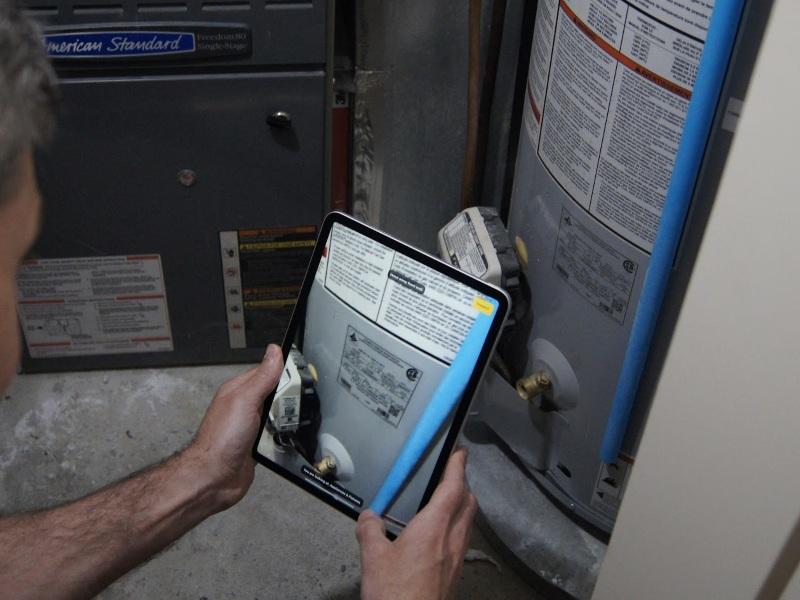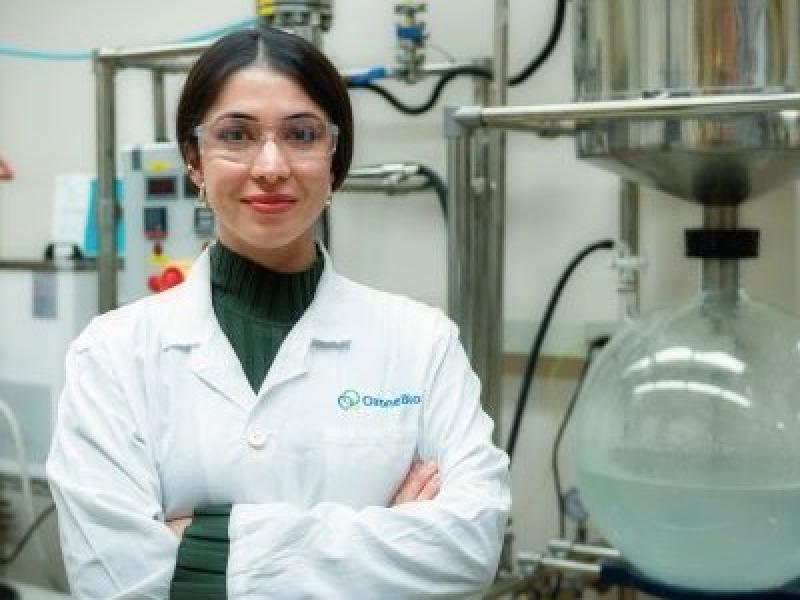
PLAN’s COO Ian Grant with a bucket of PozGlass 100G. (Courtesy Progressive Planet Solutions Inc.)
A Canadian company is one step closer to marketing a process that turns post-consumer glass into high-performance cement incorporating carbon dioxide sequestration.
In July, Progressive Planet Solutions Inc., or PLAN, filed a U.S. patent for improving the properties of ground-glass pozzolan — materials that form cementitious properties in the presence of water and calcium hydroxide.
Ground-glass pozzolan is typically used to replace up to 30 per cent of Portland cement in concrete to improve the performance characteristics and reduce its carbon footprint. The catch is that it contains sodium. When that is reduced, however, the ground glass pozzolan is stronger and better able to reduce alkali-silica reactivity (ASR).
Kamloops-based PLAN’s (PLAN-X) patent application describes a process by which its PozGlass 100G permanently sequesters carbon dioxide in post-consumer glass while also reducing sodium.
The result is a ground glass pozzolan with a low carbon footprint, better strength and better resistance to ASR.
It’s the latest in a series of products developed, or under development, by PLAN.
“We surface extract diatomaceous earth zeolite and bentonite clay from our own quarries and then, through state-of-the-art equipment and facilities, we transform those rocks into innovative products,” said Ian Grant, PLAN’s chief operating officer.
“Our ag-tech products replace harmful chemicals with organic fertilizers and insecticides that improve crop yields, soil, moisture retention and carbon sequestration, where soil better stores carbon dioxide. Then we are innovating the next generation of alternative cements to the point where we envision a future where concrete becomes a sustainable building product that absorbs and sequesters carbon dioxide.”
The production of cement, the binding agent in concrete, is responsible for about eight per cent of the world’s CO2 emissions. According to the Portland Cement Association, each pound of cement manufactured produces about 0.9 pounds of CO2.
Progressive Planet’s PozGlass
The concept for PozGlass 100G was first idealized in 2019, before being aggressively developed in 2021.
“We’ve been working on developing really good SCM (supplementary cementitious materials) for market for the last few years now. Basically, when the Canadian government announced that it was going to be shutting down coal power plants, we knew that there would be a shortage of fly ash generated,” Grant said.
“Anywhere where there was coal and it’s being shut down will be an end of the generation of fly ash, which is a good thing for our environment, but it’s tough for concrete producers.”
Fly ash is a residue left over from combusted coal and is one of the most common pozzolans used in the construction industry. All coal-fired power plants in Canada are mandated to shut down by December 2029.
As Grant tells it, PLAN saw the emerging need for alternative pozzolans and eventually turned to post-consumer glass.
As an example he cited a glass jar that, if discarded as waste, may not be fully recycled or might simply end up in a landfill. In cement, it can last for at least 30 years.
Next for the PozGlass 100G is a nine-month pilot stage to determine how fast it can process the post-consumer glass, the energy consumed in production, the carbon dioxide sequestered and the concrete’s overall performance.
That will occur at the company’s demonstration plant in Kamloops. Currently, it can produce about a 100 to 500 kgs of PozGlass 100G per day, but Grant states commercial capability would involve “tens of thousands” of metric tonnes per year. However, that is two or more years away.
“This is really our last major de-risking before we go to a fully commercial plant,” Grant said. “So we’ll be able to answer all the questions that we need to have in order to know that we’re going to be building a full-scale commercial plant that’s going to meet the needs of industry as well as our economics.”
No location has been chosen for the planned commercial plant, although Kamloops is attractive given the foundations the company already has there. According to Grant, a “dream pairing” would be for PLAN to partner with a larger cement company to spread the PozGlass 100G across North America.
The plant could be anywhere with about a million people — enough to generate the necessary amounts of glass.
Planning for the future
This month, PLAN began trading on the OTCQB venture market — for early stage or developing companies — under the ticker ASHXF.
PLAN has a related product which Grant says is much closer to commercialization: the PozDE. It’s made at PLAN’s Red Lake mine – 56 kms from its Kamloops head office – from a blend of diatomaceous earth that includes calcium bentonite. That mine is one of two in the world, and the only one in North America, that contains calcium bentonite.
The PozDE used 2 per cent less water to achieve the same flowability of the concrete than similar tests with Portland cement. Over 28 days it also registered 20 per cent stronger than regular Portland cement.
Grant states it is about six months to one year away from full commercialization.
Currently, PLAN has 21 R&D projects in the pipeline — many of which are in ag-tech, like the Activated Barn Fresh Poultry Litter Ammonia Control, which in June was approved for organic production in Canada. It’s an acidifier used to reduce ammonia in commercial broiler barns which in turn helps the chickens breath easier and creates healthier poultry.
It is also planning to release its first ESG report in September, alongside its first quarterly report.
On the business side, the question for PLAN is whether it will grow via acquisitions, by itself or both avenues. In February, it acquired Absorbent Products Ltd., since renamed to Progressive Planet Products Inc.
Outside of acquisitions, Grant cited a commercial line of regenerative fertilizers he expects will be operational by mid-fall or early spring next year as an example of the company’s organic growth.
“That option is there for us, to continue to grow through acquisition,” Grant said. “But then we’re also rolling up our sleeves and really implementing operational changes and trying to grow those operational businesses that we have.”










